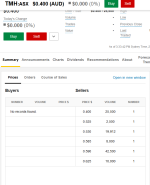Afternoon BaconLover,So far BRN has traded just below 7 million shares on ASX.
That's from 1000 to 1255hrs.
Remember those days when BRN was trading 7 million in the first 30 minutes?
There's hardly any shares for sale.
Some of those index funds imo are still buying or waiting to buy, and there'll come a time when they will HAVE to buy, and not enough shares left.
Tide is slowing starting to turn, and few more people have started to see the name of Brainchip pop up with the recent ASX200 inclusion.
I might also add, once the revenue figures starting to flow, the PE ratios for tech companies are rather high.
As FF says, make a plan, write it down in your diary, so when adrenaline is rushing through your system, you can still make reasonable decisions based on own personal financial situations.
Just clicked on your avatar picture & saw Warren Buffets picture, made me smile.
On the news today, an anonymous bidder shelled out $19,000,000.00 for a private lunch with Warren Buffet at a steakhouse in New York , with the funds going to help a homeless charity in San Francisco.
Regards,
Esq.




